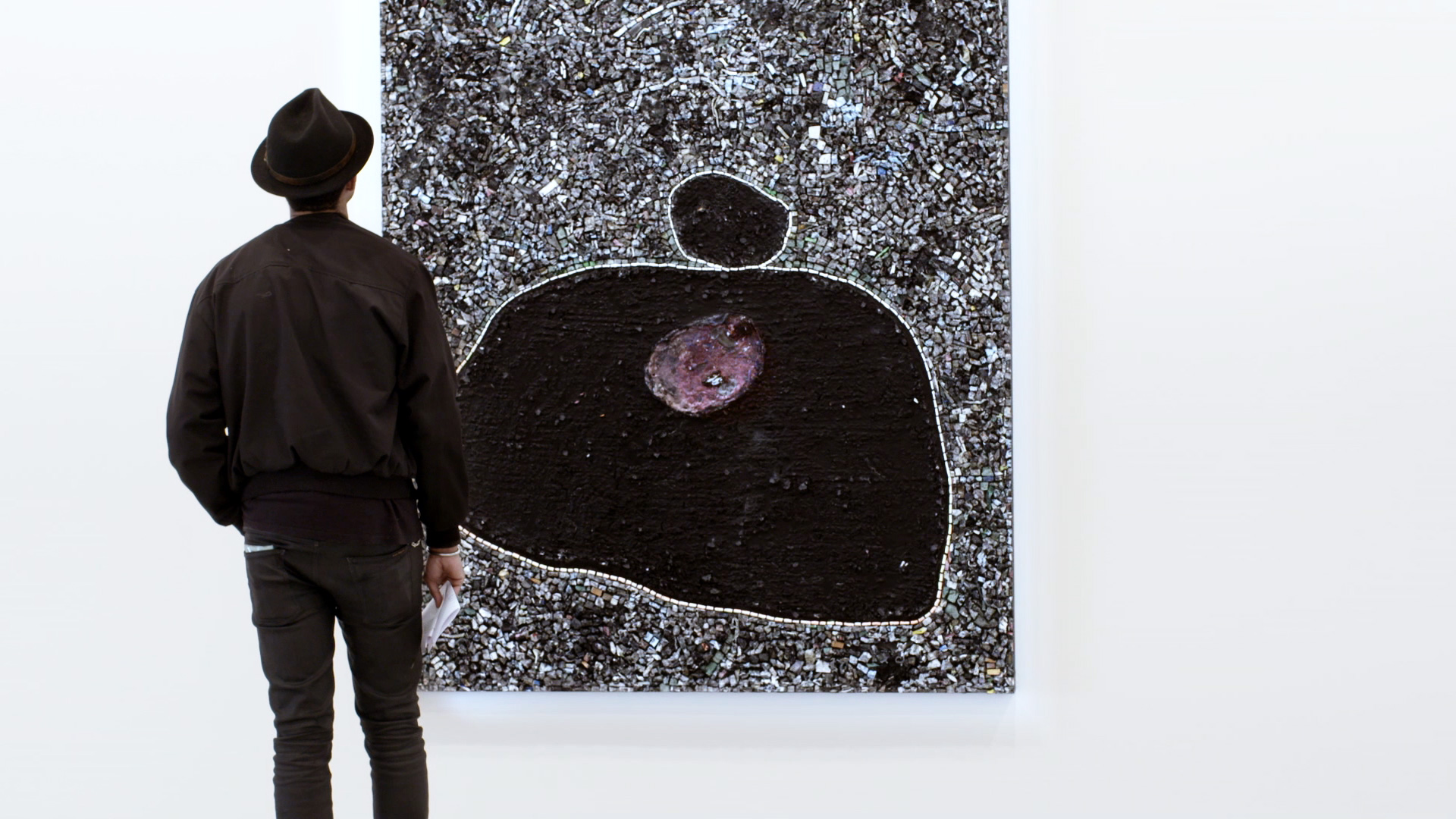
Jack Whitten. Black Monolith X, Birth of Muhammad Ali, 2016. Installation view: Hauser & Wirth. Production still from the Art21 Extended Play film, Jack Whitten: An Artist’s Life. © Art21, Inc. 2018.
In October 2017, I visited the legendary abstract painter Jack Whitten in his Queens studio. We filmed him as he created Quantum Wall, VIII (For Arshile Gorky, My First Love In Painting), completely unaware that the work would be his last. When Jack Whitten passed away in January 2018, the world lost an inventive painter, who spent his life creating new ways of approaching and redefining both his process and contemporary painting at large.
Ian Forster: What was your childhood like?
Jack Whitten: I grew up in Bessemer, Alabama. I was born in 1939, at the height of the Jim Crow era, and I grew up in an environment that was very separate from White people. It was described as “separate but equal,” but in truth it was separate but never equal. The buses had signs: “White” on the front and “Colored” on the back. You couldn’t go into the restaurants. You could walk through the park in Bessemer but couldn’t sit down. I grew up under severe conditions, what I call American apartheid.

Photographs in Jack Whitten’s studio, Queens NY, 2017. Production still from the Art21 Extended Play film, Jack Whitten: An Artist’s Life. © Art21, Inc. 2018.
IF: Why did you go to Tuskegee University? What did you study there?
JW: The school offered me a work scholarship, and I accepted it. I was a pre-medical student and an Air Force ROTC cadet. The idea was for me to be a doctor and a pilot in the U.S. Air Force, which, for someone coming out of the Black community, was a noble thing. But it was always in the back of my mind that I was an artist; I wanted to make art. I didn’t have a good understanding of what that meant. In retrospect, being in pre-med still informs what I’m doing in painting today. I was great with botany, zoology, and biology. Those were my favorite subjects, and I spent hours in the lab.
Tuskegee University was also the home of Dr. George Washington Carver, a scientist who did research on peanuts. But Dr. Carver was also a painter; he made his own pigments and painted small landscapes and still lifes. They are still there, at the school. Since I was doing janitorial work, more than once I had to clean Dr. Carver’s laboratory, which is intact, just the way he left it. So that had a big influence on my thinking. I knew about Dr. Carver before going to college because at that time, in Black schools, the instructors made sure that the students knew about notable Black people, those who had succeeded in different fields: medicine, entertainment, sports, writing.

Detail of Jack Whitten’s Quantum Wall, VIII (For Arshile Gorky, My First Love In Painting), 2017. Production still from the Art21 Extended Play film, Jack Whitten: An Artist’s Life. © Art21, Inc. 2018.
IF: How does this interest in science influence your art?
JW: Artists are not scientists. I mention science because that’s what excites me. Artists need something to fire up their imaginations, and different artists have different things. My excitement is what’s happening in science because I believe that art should reflect the period in which it’s made. It’s increasingly obvious to me that it’s evolution. As a painter, I think of painting as being organic. Therefore, painting evolves. It evolves like other organic structures.
Another thing I like about quantum mechanics is that the distinction between what is organic and inorganic breaks down. I love that, not only in its physical sense but also from a philosophical point of view. Racially, you’re Black or you’re White. Or sexually, you’re this or you’re that. I prefer a more fluid situation. [Instead of the terms this/that] I use neither/nor. It has more rhythm to it. In the [social] environments we have today, the spirit does not have a chance to flourish. People are exhausted, so they fall back on old-fashioned ideas because it’s easy. It doesn’t require any thought. It doesn’t require any effort.

Jack Whitten at work in his studio. Production still from the Art21 Extended Play film, Jack Whitten: An Artist’s Life. © Art21, Inc. 2018.
IF: After you came to New York in the early 1960s and started working as an artist, did you find that there were certain expectations of you, as a Black artist?
JW: Well, of course. Any time anybody deals with stereotypes, expectations go along with them, whether political, religious, or sexual. Being a Black artist, I faced expectations based on stereotypes: “You’re supposed to do this,” “You can’t do that.” But that’s bullshit.
Unfortunately, so many people are still stuck in that line of thought—what’s happening politically now, in America and in Europe—and it’s painful. Those old-fashioned stereotypes and severe dichotomies just erode the spirit, which is what we are witnessing today.
IF: How are you countering that in the studio?
JW: I think of the paintings as an antidote to evil. My position is: I accept life as being difficult. Coming out of the South, I’ve seen some horrible shit. I don’t even talk about it. But I have a purpose; I have an agenda. I accept the fact that it’s difficult, but I’m not going to make it harder.
Read the full interview with Jack Whitten on Art21.org.



